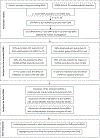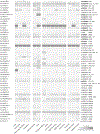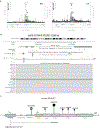A systematic analysis highlights multiple long non-coding RNAs associated with cardiometabolic disorders
- PMID: 29382920
- PMCID: PMC6894420
- DOI: 10.1038/s10038-017-0403-x
A systematic analysis highlights multiple long non-coding RNAs associated with cardiometabolic disorders
Abstract
Genome-wide association studies (GWAS) have identified many susceptibility loci for cardiometabolic disorders. Most of the associated variants reside in non-coding regions of the genome including long non-coding RNAs (lncRNAs), which are thought to play critical roles in diverse biological processes. Here, we leveraged data from the available GWAS meta-analyses on lipid and obesity-related traits, blood pressure, type 2 diabetes, and coronary artery disease and identified 179 associated single-nucleotide polymorphisms (SNPs) in 102 lncRNAs (p-value < 2.3 × 10-7). Of these, 55 SNPs, either the lead SNP or in strong linkage disequilibrium with the lead SNP in the related loci, were selected for further investigations. Our in silico predictions and functional annotations of the SNPs as well as expression and DNA methylation analysis of their lncRNAs demonstrated several lncRNAs that fulfilled predefined criteria for being potential functional targets. In particular, we found evidence suggesting that LOC157273 (at 8p23.1) is involved in regulating serum lipid-cholesterol. Our results showed that rs4841132 in the second exon and cg17371580 in the promoter region of LOC157273 are associated with lipids; the lncRNA is expressed in liver and associates with the expression of its nearby coding gene, PPP1R3B. Collectively, we highlight a number of loci associated with cardiometabolic disorders for which the association may act through lncRNAs.
Conflict of interest statement
Figures



Similar articles
-
Functional implication of celiac disease associated lncRNAs in disease pathogenesis.Comput Biol Med. 2018 Nov 1;102:369-375. doi: 10.1016/j.compbiomed.2018.08.013. Epub 2018 Aug 16. Comput Biol Med. 2018. PMID: 30126616 Review.
-
Variation in the Untranslated Genome and Susceptibility to Infections.Front Immunol. 2018 Sep 7;9:2046. doi: 10.3389/fimmu.2018.02046. eCollection 2018. Front Immunol. 2018. PMID: 30245696 Free PMC article. Review.
-
Identification of Key Long Non-Coding RNAs in the Pathology of Alzheimer's Disease and their Functions Based on Genome-Wide Associations Study, Microarray, and RNA-seq Data.J Alzheimers Dis. 2019;68(1):339-355. doi: 10.3233/JAD-181051. J Alzheimers Dis. 2019. PMID: 30776002
-
Effects of GWAS-associated genetic variants on lncRNAs within IBD and T1D candidate loci.PLoS One. 2014 Aug 21;9(8):e105723. doi: 10.1371/journal.pone.0105723. eCollection 2014. PLoS One. 2014. PMID: 25144376 Free PMC article.
-
An atlas of human long non-coding RNAs with accurate 5' ends.Nature. 2017 Mar 9;543(7644):199-204. doi: 10.1038/nature21374. Epub 2017 Mar 1. Nature. 2017. PMID: 28241135 Free PMC article.
Cited by
-
LncRNA H19 rs4929984 Variant is Associated with Coronary Artery Disease Susceptibility in Han Chinese Female Population.Biochem Genet. 2021 Dec;59(6):1359-1380. doi: 10.1007/s10528-021-10055-w. Epub 2021 Apr 7. Biochem Genet. 2021. PMID: 33826032
-
Long noncoding RNAs in lipid metabolism: literature review and conservation analysis across species.BMC Genomics. 2019 Nov 21;20(1):882. doi: 10.1186/s12864-019-6093-3. BMC Genomics. 2019. PMID: 31752679 Free PMC article. Review.
-
Objectives, design and main findings until 2020 from the Rotterdam Study.Eur J Epidemiol. 2020 May;35(5):483-517. doi: 10.1007/s10654-020-00640-5. Epub 2020 May 4. Eur J Epidemiol. 2020. PMID: 32367290 Free PMC article.
-
Lipid Phenotypes and DNA Methylation: a Review of the Literature.Curr Atheroscler Rep. 2021 Sep 1;23(11):71. doi: 10.1007/s11883-021-00965-w. Curr Atheroscler Rep. 2021. PMID: 34468868 Free PMC article. Review.
-
Relative quantification of BCL2 mRNA for diagnostic usage needs stable uncontrolled genes as reference.PLoS One. 2020 Aug 12;15(8):e0236338. doi: 10.1371/journal.pone.0236338. eCollection 2020. PLoS One. 2020. PMID: 32785215 Free PMC article.
References
MeSH terms
Substances
Grants and funding
LinkOut - more resources
Full Text Sources
Other Literature Sources
Medical
